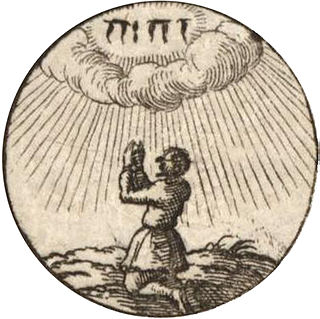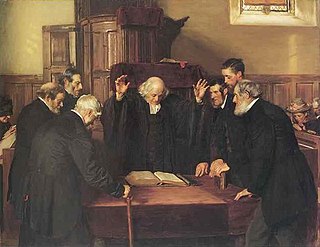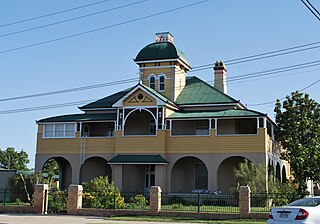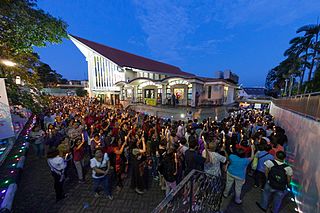Presbytery and presbyterium may refer to:
A bishop is an ordained, consecrated, or appointed member of the Christian clergy who is generally entrusted with a position of authority and oversight.

The Eucharist is a Christian rite that is considered a sacrament in most churches, and as an ordinance in others. According to the New Testament, the rite was instituted by Jesus Christ during the Last Supper; giving his disciples bread and wine during a Passover meal, Jesus commanded his disciples to "do this in memory of me" while referring to the bread as "my body" and the cup of wine as "the new covenant in my blood". Through the eucharistic celebration Christians remember both Christ's sacrifice of himself on the cross and his commission of the apostles at the Last Supper.
A parish is a territorial entity in many Christian denominations, constituting a division within a diocese. A parish is under the pastoral care and clerical jurisdiction of a priest, often termed a parish priest, who might be assisted by one or more curates, and who operates from a parish church. Historically, a parish often covered the same geographical area as a manor. Its association with the parish church remains paramount.
Presbyterianpolity is a method of church governance typified by the rule of assemblies of presbyters, or elders. Each local church is governed by a body of elected elders usually called the session or consistory, though other terms, such as church board, may apply. Groups of local churches are governed by a higher assembly of elders known as the presbytery or classis; presbyteries can be grouped into a synod, and presbyteries and synods nationwide often join together in a general assembly. Responsibility for conduct of church services is reserved to an ordained minister or pastor known as a teaching elder, or a minister of the word and sacrament.
In the New Testament, a presbyter is a leader of a local Christian congregation. The word derives from the Greek presbyteros, which means elder or senior. Although many understand presbyteros to refer to the bishop functioning as overseer, in modern Catholic and Orthodox usage, presbyter is distinct from bishop and synonymous with priest. In predominant Protestant usage, presbyter does not refer to a member of a distinctive priesthood called priests, but rather to a minister, pastor, or elder.

The universal priesthood or the priesthood of all believers is a principle in some branches of Christianity which abrogates the doctrine of holy orders found in some other branches, including the Roman Catholic and Eastern Orthodox. Derived from the Bible and elaborated in the theology of Martin Luther and John Calvin, the principle became prominent as a tenet of Protestant Christian doctrine, though the exact meaning of the belief and its implications vary widely among denominations.

Personal prelature is a canonical structure of the Catholic Church which comprises a prelate, clergy and laity who undertake specific pastoral activities. The first personal prelature is Opus Dei. Personal prelatures, similar to dioceses and military ordinariates, are under the governance of the Vatican's Congregation for Bishops. These three types of ecclesiastical structures are composed of lay people served by their own secular clergy and prelate. Unlike dioceses which cover territories, personal prelatures—like military ordinariates—take charge of persons as regards some objectives regardless of where they live.
In religious organizations, the laity consists of all members who are not part of the clergy, usually including any non-ordained members of religious orders, e.g. a nun or lay brother.

Presbyterium is a modern term used in the Catholic Church and Eastern Catholic Churches after the Second Vatican Council in reference to a college of priests, in active ministry, of an individual particular church such as a diocese or eparchy. The body, in union with their bishop as a collective, is a symbol of the collaborative and collegial nature of their sacerdotal ministry as inspired by the reforms made during the Second Vatican Council.

The term major orders or greater orders was for some centuries applied in the Roman Catholic Church to distinguish what the Council of Trent also called holy orders from what at that time were termed "minor orders" or "lesser orders". The Catechism of the Council of Trent spoke of the "several distinct orders of ministers, intended by their office to serve the priesthood, and so disposed, as that, beginning with the clerical tonsure, they may ascend gradually through the lesser to the greater orders", and stated:

A chapter is one of several bodies of clergy in Roman Catholic, Old Catholic, Anglican, and Nordic Lutheran churches or their gatherings.
A local church is a church or congregation meeting in a particular location.

A Church of Scotland congregation is led by its minister and elders. Both of these terms are also used in other Christian denominations: see Minister (Christianity) and Elder (Christianity). This article discusses the specific understanding of their roles and functions in the Scottish Church.

The priesthood is one of the three holy orders of the Catholic Church, comprising the ordained priests or presbyters. The other two orders are the bishops and the deacons. Church doctrine also sometimes refers to all baptised Catholics as the "common priesthood".
In Christianity, an elder is a person who is valued for wisdom and holds a position of responsibility and authority in a Christian group. In some Christian traditions an elder is an ordained person who serves a local church or churches and who has been ordained to a ministry of word, sacrament and order, filling the preaching and pastoral offices. In other Christian traditions, an elder may be a lay person serving as an administrator in a local congregation, or be ordained and serving in preaching or pastoral roles. There is a distinction between ordained elders and lay elders. The two concepts may be conflated in everyday conversation. In non-Christian world cultures the term elder refers to age and experience, and the Christian sense of elder is partly related to this.
In 1983 the Catholic Church introduced the possibility of entrusting the pastoral care, of one or more parishes to a team of priests in solidum. This provision in the 1983 Code of Canon Law, which resembles ancient models of pastoral care in the Roman titular churches with their colleges of priests, was introduced to help resolve some of the difficulties facing many dioceses. These difficulties include shortages of priests, overpopulated urban parishes, depleted and scattered rural parishes, and decline in attendance at Mass. This model of pastoral care is viewed as a practical way of promoting pastoral co-responsibility, as well as fostering a greater sense of the presbyterium among the priests of a diocese.

St. Anthony's Church, Lahore, located 270 kilometers southeast of Islamabad is one of the oldest churches in the Roman Catholic Archdiocese of Lahore in Pakistan.

St Mary's Presbytery is a heritage-listed Roman Catholic presbytery of St Mary's Roman Catholic Church at 142 Palmerin Street, Warwick, Southern Downs Region, Queensland, Australia. It was designed by Wallace & Gibson and built from 1885 to 1887 by John McCulloch. It is also known as Father JJ Horan's private residence. It was added to the Queensland Heritage Register on 31 July 2008.

St Mary's Roman Catholic Church is a heritage-listed church precinct at Mary Street, Ipswich, City of Ipswich, Queensland, Australia. It was built from 1874 to 1970s. It is also known as the former St Brigids Convent. It was added to the Queensland Heritage Register on 21 October 1992.

The Church of Our Lady of Perpetual Succour, also known as OLPS Church, is a Roman Catholic church in the Archdiocese of Singapore. It is located at Siglap Hill, Singapore, within the Siglap housing estate, near the Kembangan MRT station.